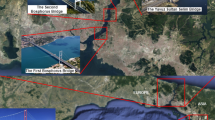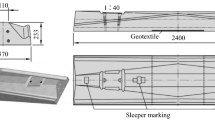Abstract
Existing open-steel-plate-girder (OSPG) railway bridges in Korea are so old that they can no longer provide the desired ride quality when trains pass over them due to loss of integrity. In addition, existing bridges do not have ballast, thus impacts from passing trains are delivered directly to piers and abutments. The damage that accumulated is one of the main causes of cracks in pier concrete. To cure this problem, replacement of the existing bridges is required. However, since they are still in service, conventional construction methods cannot be used for their replacement. A new method is necessary to quickly replace the existing bridges in a way that does not disturb the existing train schedule. In this study, a new accelerated-replacement method is proposed using a newly developed crane-vehicle which possesses cranes able to lift a replacement bridge, and which is able to travel on existing train tracks. This study also addresses the design and manufacture of a new bridge deck appropriate for accelerated-replacement construction. Finite element analyses and experimental tests were conducted to estimate the performance of the new bridge deck. The analyses included a static load case and dynamic analysis at various train speeds. The experimental tests included static loading and modal tests to capture the fundamental natural frequency and damping ratio of the bridge deck, and a dynamic amplification test. The results of this study can be used for practical replacement of aged existing open-steel-plate-girder bridges and to improve the integrity and ride quality of railway bridges in Korea.
Similar content being viewed by others
References
Choi, E., Kim, H. M., Oh, J. T., and Kim, S. G. (2005). “Analysis of dynamic behavior of open-steel-plate-girder bridges due to installing rubber pads.” Journal of Korean Society of Steel Construction, 17(3), pp. 295–306 (in Korean).
Choi E., Hwang, S. K., and Lee, J. S. (2006). Evaluation of earthquake-resistance ability and corresponding strengthening strategies for current Korean railroad structures. Research Report, Korea Railroad Res. Inst., Uiwang, Korea (in Korean).
Choi, E., Lee, J. S., Jeon, H. K., Park, T., and Kim, H. T. (2010a). “Static and dynamic behavior of disk bearings for OSPG railway bridges under railway vehicle loading.” Nonlinear Dynamics, 62, pp. 73–93.
Choi, J. Y., Park, Y. G., Choi, E., and Choi, J. H. (2010b). “Applying precast slab panel track to replace timber track in an existing steel plates girder railway bridge.” Proc. IMechE., Vol. 224, Park F: J. Rail and Rapid Transit, pp. 159–167.
Choi, E., Rhee, I., Park, J., and Cho, B. S. (2011). “Seismic retrofit of plain concrete piers of railroad bridges using composite of FRP-steel plates.” Composites: Part B, 42, pp. 1097–1107.
Choi, E. and Choi, S. H. (2012). “Analysis of dynamic behavior of railroad steel bridges according to bridge bearing types.” Journal of the Korean Society for Railway, 15(1), 62–70 (in Korean).
IDEAS (2004). IDEAS finite element analysis program. International Design Engineering & Service Ltd., Glasgow, Scotland.
Lee, S. W. (2000). Maintenance report of steel structures in Korean railroad. Research Report, KORAIL, Daejeon, Korea (in Korean).
Lee, C. H. (2003). Railroad damage statistics due to natural disaster and rehabilitation strategies. Research Report, KORAIL, Daejeon, Korea (in Korean).
Kim, J. W. and Jung, H. Y. (2012). “Vibrational Characteristics of the Deteriorated Railway Plate Girder Bridge by Fullscale Experimental Modal Analysis.” Journal of Korean Society of Steel Construction, 24(1), pp. 119–128 (in Korean).
Kim, S. I., Lee, J., and Kim, S. (2011). “Dynamic behavior comparison of steel-composite and concrete high speed railway bridges.” International Journal of Steel Structures, 11(4), pp. 445–455.
Park, J. and Choi, E. (2011). “Fragility analysis of track-on steel-plate-girder railway bridges in Korea.” Engineering Structures, 33, pp. 696–705.
Rhee, I., Choi, E., Kim, H. T., and Roh, Y. S. (2011). “Overturning of a reinforced concrete gravity bridge pier on a sandy bed.” Soli Mechanics and Foundation Engineering, 48(5), pp. 169–176.
SAP2000 (1997). Integrated finite elements analysis and design of structures. Computers and Structures, Inc., Berkeley, California, USA.
Author information
Authors and Affiliations
Corresponding author
Rights and permissions
About this article
Cite this article
Choi, E., Kim, H. & Tae, G. A new accelerated-replacement method and full-scale test of a new superstructure for existing OSPG railway bridges. Int J Steel Struct 14, 501–512 (2014). https://doi.org/10.1007/s13296-014-3007-8
Received:
Accepted:
Published:
Issue Date:
DOI: https://doi.org/10.1007/s13296-014-3007-8




